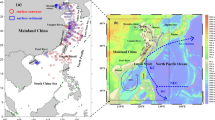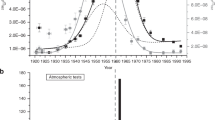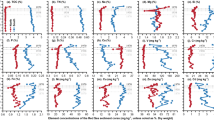Abstract
The Chernobyl accident caused a variety of radionuclides to be released. The most abundant of the longer-lived nuclides were the two caesium isotopes 137Cs and 134Cs, with half lives of 30 yr and 2.06 yr respectively1. For many years2–5 these radionuclides have been used as oceanographic tracers in the north-east Atlantic Ocean. Their sources are the fuel reprocessing plants in Western Europe. The radiocaesium released from Chernobyl, however, was deposited very inhomogeneously6, thus seriously perturbing its use as a tracer. So, there is a need to identify another tracer with the same sources but unperturbed by input from Chernobyl. Technetium-99 is not sedimented to any great degree and thus as a conservative tracer7 can be considered as a candidate. In a recent study2 we found the same dilution factor for technetium as for radiocaesium when comparing concentrations in the North Sea with those in coastal waters around Greenland, supporting the idea of technetium as a substitute tracer for radiocaesium. Here we report a study of the possible contributions to 99Tc in order to determine the Chernobyl input. We chose the Baltic Sea for our study because it probably shows higher concentrations of Chernobyl debris than any other sea. We show that the Chernobyl contribution is such that 99Tc can be used as a tracer.
This is a preview of subscription content, access via your institution
Access options
Subscribe to this journal
Receive 51 print issues and online access
$199.00 per year
only $3.90 per issue
Buy this article
- Purchase on Springer Link
- Instant access to full article PDF
Prices may be subject to local taxes which are calculated during checkout
Similar content being viewed by others
References
ICRP Publication 38 (Pergamon, Oxford-New York-Frankfurt, 1983).
Aarkrog, A. et al. Estuar. Coast. Shelf Sci. 24, 637–647 (1987).
Jefferies, D. F., Steele, A. K. & Preston, A. Deep Sea Res. 29, 713–738 (1982).
Kautsky, H. Dt. hydrogr. Z. 40, 49–69 (1987).
Livingston, H. D., Bowen, V. T. & Kupferman, S. L. J. mar. Res. 40, 1227–1258 (1982).
Devell, L., Aarkrog, A., Blomqvist, L., Magnusson, S. & Tveten, U. Nuclear Europe VI, 16–17 (1986).
Tech. Rep. Ser. 247: Sediment K d s and Concentration Factors for Radionuclides in the Marine Environment (Int. Atomic Energy Agency, Vienna, 1985).
Holm, E., Rioseco, J. & Mattsson, S. in Technetium in the Environment (eds Desmet, G. & Myttenaere, C.) 61–68 (Elsevier, 1984).
Meereskudliche Beobachtungen und Ergebnisse Nr62 (Deutsches Hydrographisches Institut, Hamburg, 1987).
Buesseler, K. O. et al. Nature 329, 825–828 (1987).
Holm, E., Rioseco, J. & Garcia-Leon, M. Nucl. Instrum. Meth. Phys. Res. 223, 204–207 (1984).
Chen, Q., Aarkrog, A., Dick, H. & Mandrup, K. Risø-M-2671 (Risø National Laboratory, 1987).
Aarkrog, A. et al. Risø-R-540 (Risø National Laboratory, 1987).
Harley, J. H. HASL-300 (Environmental Measurements Laboratory, New York, 1972).
Till, J. E. in Technetium in the Environment (eds Desmet, G. & Myttenaere, C.) 1–20 (Elsevier, 1984).
Summary Report on the Post-Accident Review Meeting on the Chernobyl Accident Safety Series No 75-INSAG-l (IAEA, Vienna, 1986).
ApSimon, H. M., Macdonald, H. F. & Wilson, J. J. N. J. Soc. radiol. Prot. 6, 109–119 (1986).
Environmental Health Series No 24: Health Hazards from Radiocaesium Following the Chernobyl Nuclear Accident (World Health Organization, Copenhagen, 1987).
Study of Radioactive Materials in the Baltic Sea IAEA-TEC-DOC-362 (Int. Atomic Energy Agency, Vienna, 1986).
Salo, A. & Voipio, A. Mar. Pollution Bull. 12, 218–224 (1981).
Blaylock, B. G., Frank, M. L., Hoffman, F. O. & De Angelis, D. L. in Technetium in the Environment (eds Desmet, G. & Myttenaere, C.) 79–89 (Elsevier, 1984).
UNSCEAR, Ionizing Radiation: Sources and Biological Effects (United Nations, New York, 1982).
BNFL Annual Reports on Radioactive Discharges and Monitoring of the Environment (British Nucl. Fuels Ltd. Risley, 1978–85).
Author information
Authors and Affiliations
Rights and permissions
About this article
Cite this article
Aarkrog, A., Carlsson, L., Chen, Q. et al. Origin of technetium-99 and its use as a marine tracer. Nature 335, 338–340 (1988). https://doi.org/10.1038/335338a0
Received:
Accepted:
Issue Date:
DOI: https://doi.org/10.1038/335338a0
This article is cited by
-
Sorption behavior of fission products (Tc, I) in marine and freshwater bottom sediments
Journal of Radioanalytical and Nuclear Chemistry (2024)
-
Determination of 99Tc in environmental samples and depleted uranium penetrators using ICP-MS
Journal of Radioanalytical and Nuclear Chemistry (2017)
-
Present status and perspective of radiochemical analysis of radionuclides in Nordic countries
Journal of Radioanalytical and Nuclear Chemistry (2016)
-
Determination of rhenium in manganese nodules by inductively coupled plasma mass spectrometry
Journal of Radioanalytical and Nuclear Chemistry (2007)
-
Use of IAEA reference materials (IAEA-373 and 375) as low-level99Tc references
Journal of Radioanalytical and Nuclear Chemistry (1999)
Comments
By submitting a comment you agree to abide by our Terms and Community Guidelines. If you find something abusive or that does not comply with our terms or guidelines please flag it as inappropriate.



